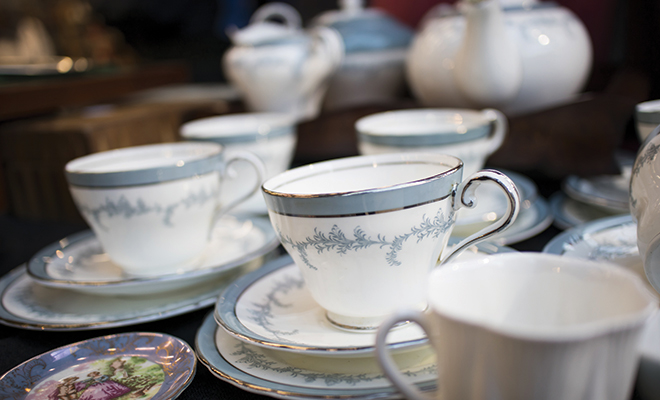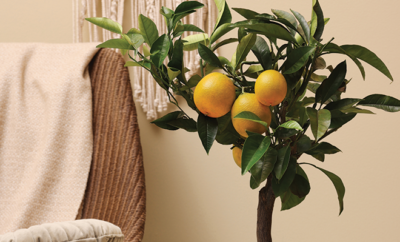
Collectible China and Pottery
Do you browse antiques shops and estate sales searching for a rare piece that brings you joy? Perhaps your tastes have a modern, eclectic flair and you seek the handcrafted elegance of contemporary clay.
C hina and pottery remain one of the most interesting, varied and affordable items sought by today’s collectors. A family heirloom or your eye for beauty and function may have piqued your curiosity and led you into dusty corners.
I inherited my grandmother’s Homer Laughlin dinner set simply because no one else wanted it. The gold-rimmed, scalloped shapes in soft pinks and greens are lovely; I began using it as everyday china. A recent Internet search using the backstamp A47 N8 revealed that the pattern is Maple Leaf produced in January 1947, and a flat cup and saucer in excellent condition is valued at $28.
The Homer Laughlin Company was launched in 1876 in East Liverpool, Ohio, by Homer Laughlin. By 1886 the factory was able to produce fine china, evidenced by the attribute of translucence, a vital characteristic of vitreous china. Prior to this time, china had to be imported, particularly from England. Laughlin symbolized his taking on the English china industry in his back stamp, an eagle attacking a lion lying helplessly on its back. With creative designers and expert ceramic engineers, HLC produced enormous amounts of china for American dinner tables. In 1935 it introduced the wildly popular Fiesta™ line; today, an antique piece of Fiesta is a rarity worth acquiring. In 1986, Fiesta was reintroduced as a lead-free product in its classic shapes with contemporary colors.
A china factory or pottery frequently originated where natural ingredients–kaolin clay and feldspar–and transportation intersected. Southern Potteries, Inc., of Erwin, Tennessee, is a prime example, beginning production around 1917 using coal-fired kilns and employing skilled pottery tradesmen imported from the East Liverpool, Ohio, area. In the early 1920s the plant’s purchaser, Charles W. Foreman, revolutionized Southern Potteries by using the technique of hand painting under glaze. The decoration was done freehand by applying a metallic base color with sponge or brush to the bisque before glazing. Local women were trained in the freehand painting; in about 1938, Southern Potteries moved to full hand painting, and Blue Ridge “Hand Painted Under the Glaze” dinnerware was born. Compared to the rigid, decal-applied patterns of other dinnerware producers, the fresh, uninhibited freestyle approach of Blue Ridge was an instant success and sold in large quantities in cities across the country. Sadly, the company closed in 1957. If you are fortunate to find several pieces in one pattern, look for the artist’s individual touch in the painting details for surprises.
McCarty’s Pottery of Merigold, Mississippi, has feet firmly in the antique and contemporary worlds of collectible pottery. Following World War II, Lee McCarty and his wife “Pup” established themselves in Oxford, Mississippi, as freelance artists; their website notes that William Faulkner allowed them to dig clay for their first pieces behind his historic home, Rowan Oak. The couple started McCarty’s Pottery in 1954 and by the early ’60s had shown in museums and exhibits including the Denver Museum of Art and The America House in New York. McCarty’s artistic, functional pieces are known worldwide for signature glazes and the trademarked “river” on each contemporary piece.
Tena Payne, artisan potter and founder of Earthborn Pottery, said, “Pottery is collectible primarily when the individual enjoys the product and the product has a strong identity and broad reach. Collecting allows the individual to create a personal style and have a truly unique look, mixing and matching glazes and plating styles.” Payne diversified into restaurant ware because, “As an artist, I’ve always been concerned with selling my work. It’s one thing to enjoy making something, but you don’t want it sitting around your feet forever. Restaurants allow me to reach a wider audience.” Earthborn’s dishes have been featured on Iron Chef America. Each one-of-a-kind piece is prized by its user for organic design and abrasion-resistant glaze, not to mention that it’s oven and dishwasher safe. “Earthborn is American-made, created with years of experience and love for the process. It is beautiful and unique in a world of ‘look-alikes,’ even in the face of those trying to emulate the distinctive look, which comes from working closely with the earth.”
Collectibles are an extension of your personality and style and aren’t only for display. China and pottery by their nature are meant to be durable and functional. Try mixing patterns that are complementary for an eclectic look; use a special selection for a centerpiece.
Learn something new about “that pretty old hand-me-down plate,” and an estate sale find or a visit to an artisan craft fair may turn into a collection you’ll be proud to pass on to your heirs. ■
Sources: earthbornpottery.net, mccartyspottery.com, replacements.com, robbinsnest.com and southernpotteries.com.







